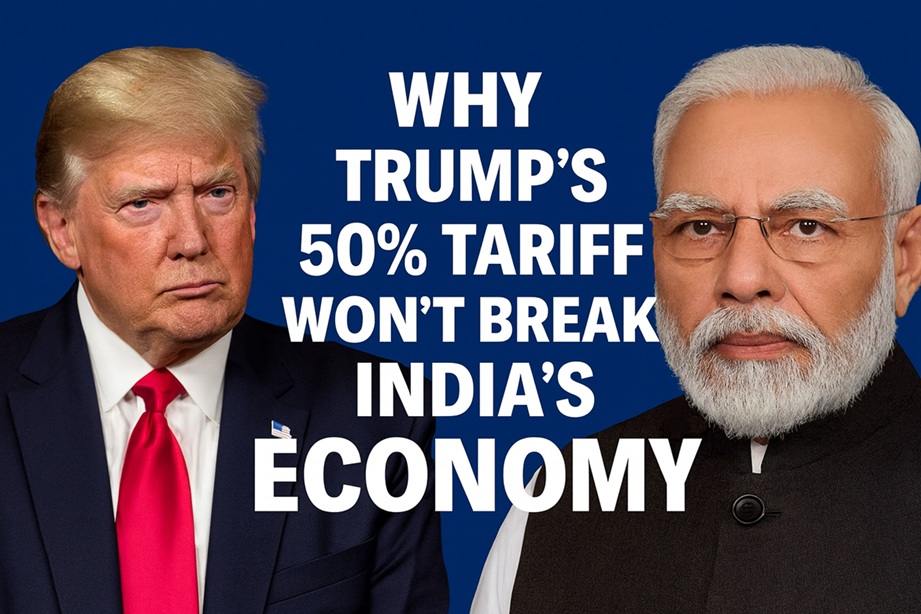The United States has officially imposed an additional 25% tariff on Indian goods starting today, bringing the total tariff burden to 50%. The move, announced by U.S. President Donald Trump, is widely seen as an attempt to pressure India into cutting back its purchase of Russian oil.
Yet the reality is strikingly different: while Trump may have expected this “tariff bomb” to shake India, it exploded without impact. Prime Minister Narendra Modi has sent a clear and firm message — India will not bow under any circumstances.
India’s Counter-Strategy: Resilience over Retreat
Prime Minister Narendra Modi responded firmly, declaring that India will not bend under pressure. The government has assured that farmers, small industries, and labor-intensive sectors will be shielded from the impact. In fact, the administration had already prepared contingency plans, including tax relief, subsidies, and credit support for exporters.
Key steps include:
👉 Make in India & Atmanirbhar Bharat: Strengthening Make in India and Atmanirbhar Bharat to reduce import dependence.
👉 Consumer Push for Local Products: Encouraging Indians to “buy Indian” and shift demand away from foreign goods.
👉 Financial Relief & Credit Support: Providing emergency credit, subsidies, and assistance to exporters and industries most affected.
👉 Tax Adjustments: Reducing certain duties to keep Indian goods competitive in global markets.
👉 Market Diversification: Finding new buyers across Asia, Africa, and Europe to reduce reliance on the U.S.
The government is confident that within 3–4 months, India will be able to neutralize the impact of Trump’s tariffs entirely.
Why Trump’s Strategy is Crumbling
Trump’s announcement was designed as an economic weapon, but it risks becoming a political boomerang.
✅ Limited Damage to India: Out of total Indian exports to the U.S., only about 55% are affected, largely in textiles, leather, chemicals, plastics, and gems. These industries are already being shielded through domestic relief measures.
✅ Impact on American Consumers: Tariffs don’t mean India pays more; rather, it is American buyers who now face higher costs. Indian goods will continue to be exported, but at higher prices for U.S. consumers.
✅ Global Backlash: By expanding tariffs not just on India but also on countries like Japan, Australia, Taiwan, and China, Trump risks undermining America’s own alliances. Even U.S. industry leaders are now warning that these policies will worsen domestic inflation and isolate America globally.
✅ Geopolitical Miscalculation: U.S. insiders, reported by Politico, admit there is growing unease in Congress and the Senate. If India, China, and Russia show deeper unity, Washington’s long-term dominance — economic and strategic — could be severely undermined.
Trump’s Inconsistent Rhetoric
Adding to the confusion are Trump’s erratic public statements. At one moment he dismisses the India-Pakistan conflict as “not America’s business,” then exaggerates casualty numbers in airstrikes, and later claims credit for “stopping a war” after allegedly pressuring Modi over a phone call.
Indian officials, however, have flatly denied such claims. Defense Minister Rajnath Singh and Naval Chief statements confirm that India’s military operations are ongoing and uncompromised.
Such contradictions have weakened Trump’s credibility not just in Washington, but globally. Even during a recent press conference, the former President reportedly faced embarrassment and abruptly left without attending the scheduled lunch.
Opposition’s Misplaced Celebration
In India, some opposition leaders — including Rahul Gandhi and Jairam Ramesh — have attempted to portray the U.S. tariffs as a setback for Modi. However, critics argue that celebrating foreign sanctions against one’s own country reflects a deeply flawed mindset. Instead of rallying behind the nation during a crisis, opposition voices appear to be echoing Trump’s rhetoric.
The New India: Standing Firm
The larger picture is clear: Trump’s tariff bomb has fizzled against India’s resilience. Modi’s Atmanirbhar Bharat (Self-Reliant India) strategy has transformed this challenge into an opportunity to strengthen domestic industries, explore new markets, and reduce dependence on Western economies.
In fact, the move may well accelerate India’s economic independence, leaving Trump cornered both at home and abroad. Even U.S. lawmakers are now pressing the administration to reconsider, fearing that alienating India could push New Delhi closer to Moscow and Beijing.
Conclusion
The tariff dispute’s outcome reveals a significant strategic miscalculation. Trump’s pressure tactics have not only failed to coerce India but have instead catalyzed a declaration of strategic autonomy. This episode elevates Modi’s stature as a defiant global leader and underscores a new reality for Washington: India is a partner to be negotiated with, not a subordinate to be commanded.
#trump, #trumptariffs, #dailydozes, #india, #usindiarelation, #donaltrump, #newdelhi, #russia, #russianoil, #unitedstates, #ustariffs, #tradewar, #modidiplomacy, #uschinarelations, #washington, #jdvance, #tradedispute, #uspolitics, #tradepolicy,
Discover more from DailyDozes NEWSPAPER
Subscribe to get the latest posts sent to your email.
